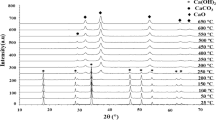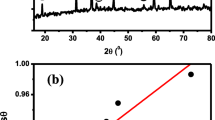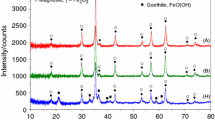Abstract
The decomposition of zinc hydroxide carbonate, Zn5(CO3)2(OH)6 (ZHC), into the high surface area form of ZnO known as “active zinc oxide” is examined. In particular, the nucleation and evolution of the ZnO nanocrystals is of interest as the size of these particles controls the activity of the product. The decomposition process was studied using X-ray diffraction, thermogravimetric analysis, scanning electron microscopy, transmission electron microscopy and BET surface area measurements. At about 240 °C ZHC decomposes to porous ZnO in a single step. The product material has a specific surface area in the range of 47–65 m2 g−1 and initially has a crystallite size that is of the order of 10 nm. A further increase in temperature, however, causes the particles to coarsen to over 25 nm in diameter. In principle, the coarsening phenomenon may be interrupted to control the particle size.










Similar content being viewed by others
References
Auer G, Griebler W-D, Jahn B (2005) Industrial inorganic pigments. Wiley-VCH Verlag GmbH and Co. KGaA, Weinheim
Castellano M, Matijevic E (1989) Uniform colloidal zinc compounds of various morphologies. Chem Mater 1:78–82
Dollimore D, France JA, Krupay BW, Whitehead R (1980) Kinetic aspects of the thermal decomposition of zinc carbonate. Thermochim Acta 36:343–349
Kanari N, Mishra D, Gaballah I, Dupré B (2004) Thermal decomposition of zinc carbonate hydroxide. Thermochim Acta 410:93–100
Li Z, Shen X, Feng X, Wang P, Wu Z (2005) Non-isothermal kinetics studies on the thermal decomposition of zinc hydroxide carbonate. Thermochim Acta 438:102–106
Liandi S (1995) World development of active zinc oxide. Mod Chem Ind 7:12–14 (in Chinese)
Liu Y, Zhao J, Zhang H, Zhu Y, Wang Z (2004) Thermal decomposition of basic zinc carbonate in nitrogen atmosphere. Thermochim Acta 414:121–123
Moezzi A, Cortie M, McDonagh A (2011) Aqueous pathways for the formation of zinc oxide nanoparticles. Dalton Trans 40:4871–4878
Moezzi A, McDonagh AM, Cortie MB (2012) Zinc oxide particles: synthesis, properties and applications. Chem Eng J 185–186:1–22
Moezzi A, Cortie MB, McDonagh AM (2013a) Zinc hydroxide sulphate and its transformation to crystalline zinc oxide. Dalton Trans 42:14432–14437
Moezzi A, McDonagh A, Dowd A, Cortie M (2013b) Zinc hydroxyacetate and its transformation to nanocrystalline zinc oxide. Inorg Chem 52:95–102
Nip RL (2003) Method of preparing zinc ammonia carbonate solution. United States Patent 20030152508
Nobari AH, Halali M (2006) An investigation on the calcination kinetics of zinc carbonate hydroxide and Calsimin zinc carbonate concentrate. Chem Eng J 121:79–84
Robinson VS (1978) Method for preparing particulate zinc oxide shapes of high surface area and improved strength. United States Patent 4,071,609
Sawada Y, Murakami M, Nishide T (1996) Thermal analysis of basic zinc carbonate. Part 1. Carbonation process of zinc oxide powders at 8 and 13 °C. Thermochim Acta 273:95–102
Wojdyr M (2010) Fityk: a general-purpose peak fitting program. J Appl Crystallogr 43:1126–1128
Acknowledgments
This work was supported by PT. Indo Lysaght (Indonesia). The in situ XRD was undertaken on the Powder Diffraction beamline at the Australian Synchrotron, Victoria, Australia.
Author information
Authors and Affiliations
Corresponding author
Rights and permissions
About this article
Cite this article
Moezzi, A., Cortie, M., Dowd, A. et al. On the formation of nanocrystalline active zinc oxide from zinc hydroxide carbonate. J Nanopart Res 16, 2344 (2014). https://doi.org/10.1007/s11051-014-2344-z
Received:
Accepted:
Published:
DOI: https://doi.org/10.1007/s11051-014-2344-z




